
Basketry
Southern California basketry, tóonavish, is recognized worldwide for its quality. Our baskets are renowned for their exceedingly tight weaves, beautiful textures, and intricate designs. The Pechanga Cultural Center and Government Center frequently exhibit a number of Pechanga's carefully preserved baskets.
Our baskets are vital to our culture, traditions, and history. Their designs – some of which are quite intricate – often capture an event in time, tell a story (often known only to the weaver), or reveal the cultural connections of the weaver. The shapes and sizes of the baskets are also as varied as their patterns.
A Basket Revitalization
Amongst many Tribal nations, basket weaving, practiced since time immemorial, is enjoying a contemporary resurgence. The ‘atáaxum have long held a desire to protect and revitalize this important element of California Indian culture. Now, many modern weavers are finally receiving proper compensation for their work. Years – and often decades – of weaving develop one's reputation as a weaver, and skilled teachers are highly respected in the Native community.Pechanga basket weavers, like those from many tribes, face the constant challenge of finding places to gather basket materials, and some have become vocal advocates of sustainable land use. Their work educates agencies, environmental groups, and the public about traditional plant management techniques as practiced by Native American basket weavers. Through methods such as pruning, digging, sowing, burning and selective harvesting, they show how to achieve optimum plant growth and desired characteristics among Native plant species.
Most traditional gathering sites have been lost to private property owners, development, agriculture, and so on. In response to this crisis, some California Native basket weavers, as de facto site monitors, have initiated an open dialogue with agencies such as the Forest Service, Bureau of Land Management (BLM), National Park Service, and California Department of Parks and Recreation. The first Basket Weavers Gathering in 1991, an inter-tribal effort, created a forum where basket weavers could speak directly to representatives of public land agencies. Their work helps to affect change in state and national environmental policies while bringing an increased knowledge of the value of traditional native land/resource management priorities and practices for use in a variety of projects.
The Pechanga tribe honors everyone who is dedicated to the effort required to become a weaver.
BASKETRY MATERIALS:
Basketry is more than just weaving. It represents a balance with the environment: Collecting, preparing, aging, and dyeing the necessary materials must all be done at specific times of the year. Today, weavers are constantly searching for the best materials, which is sometimes the result of a prime growing location, but more often, it is the outcome of special care given by the weavers. This includes annual harvesting or pruning, burning when possible, and polite conversation: a good weaver will always talk to the plants. Some of these plants are hundreds of years old and have been visited by several generations of weavers, so they know us well.
 |
Preparation of weaving materials can be very tedious. The deergrass flower stalks need to be stripped of their seeds and chaff. This requires slow and patient passing of the flower stalk through a leather strip. (A weaver will often suffer several fine splinters piercing fingers and hands as the work progresses. The splinters usually resist being removed by simply breaking up beneath the skin and refusing the grip of tweezers.) |
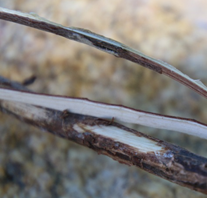 |
Sumac, which is also called skunk bush or sour berry, must be collected when the sap is down, preferably in late winter. The long, leafless stalks are collected and split into two or three pieces. Each weaver will develop a personal preference on preparing sumac. It is easier to split and size the material immediately after harvest, but some weavers prefer to split the material and then dry it for up to two years before sizing because dried sumac doesn’t smell as much. The strips are usually white in color and are most often used undyed. |
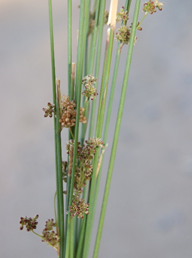 |
Juncus, also known as wire grass, is another plant used in weaving. The stalks of the juncus are gathered and split into three pieces just like sumac. Like sumac, preparation of juncus is dependent upon the preferences of the weaver. Juncus produces a green stalk and will retain its color until it is exposed to sunlight. At the base of the stalk, juncus will produce a length of reddish-brown material varying in length from a few inches up to eighteen inches before turning green. This brown or red juncus is one of the common colors used in weaving the designs in the baskets. Once juncus is split and sized, it is placed in the sun so that the green color can be bleached out. Once the pieces are bleached, they are ready to be dyed. Many agents can be used to dye juncus, including walnut hulls, elderberry leaves, iron-rich mud, and even rusty nails. The juncus and dyeing agents are placed in a container of water and soaked for two weeks. The result is black juncus.
|
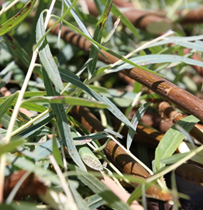 |
Red Willow is the primary material from which large granary baskets are made. Willow granaries are traditionally used to store acorns. |
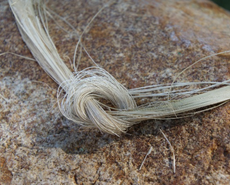 |
Yucca Fiber Yucca fibers are often used as the foundation for a basket's start. |
Weaving Techniques:
Traditional Pechanga weaving techniques share many similarities with other Tribes of Southern California. We make our baskets using the Coil Method – wrapping deergrass bundles with a strip made from juncus or sumac.
Starting a basket is considered to be one of the most difficult parts of weaving. Most baskets are started by forming a bundle with yucca fiber, and then wrapping it with the selected material. After completing two or three rounds, the weaver begins to insert flower stalks from the deergrass until the yucca fiber is spent and the stalks make up the main foundation of the basket.
An awl is used to pierce the top edge of the bundle so that the juncus or sumac can be passed through and wrapped around the successive bundle. Awls are made of bone, metal, or a cactus thorn. A deer bone awl was preferred prior to European contact but was often replaced with metal needles when they became available. Most weavers now utilize both bone and metal awls depending upon the material and the style of the weave.
Patterns:
‘Atáaxum baskets often feature two or more horizontal black bands, and/or diamonds, squares, triangles, or zigzags, “net” patterns of connected diamonds, “stair steps” of bands or boxes, or “whirlwind” designs. Some of these designs can also be seen in pre-contact rock art today, and their use in multiple art forms indicates that the images are significant.

Depictions of animals and plants native to Southern California are common themes seen on many baskets. These images may be representations of things that people saw every day, that were artistically pleasing to the weaver, or they may have a deeper, spiritual meaning known only to the artist.
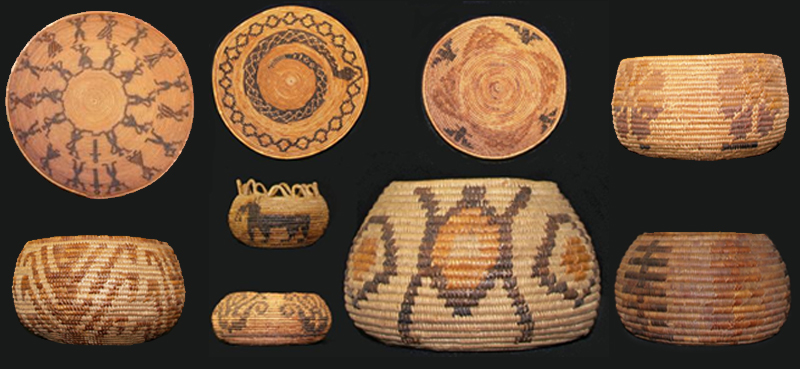
The use of human figures in Southern California basketry is rare. The baskets that show groups of people together may have been created to commemorate celebrations or other important gatherings, while the baskets with lone human figures may represent family members, tribal leaders, or people who played significant roles in oral histories.


